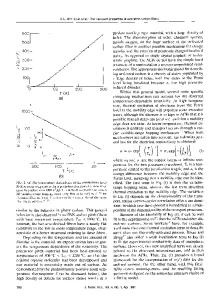Photoconductivity of activated carbon fibers
- PDF / 880,795 Bytes
- 8 Pages / 576 x 792 pts Page_size
- 16 Downloads / 364 Views
I. INTRODUCTION
Study of the electronic properties of disordered systems is currently an area of active interest. In the case of carbon materials, interesting phenomena that are not observed in graphitic systems have been reported in some disordered carbons, such as Saran carbon rods (in terms of their conductivity1), active carbon rods (in terms of their resistivity2'3), evaporated carbon films (in terms of their resistivity,4'5 photoconductivity,6 optical absorption edge,7 adsorption,8'9 and ESR10), anthracite carbon powders (in terms of their electrical properties11), glassy carbons,12"14 and others.15"20 A series of systematic investigations on the electronic properties of various types of carbon materials have been carried out by Mrozowski.21"27 Activated carbon fibers (ACFs) are expected to show electronic behavior characteristic of disordered systems, since ACFs are a highly disordered carbon material with high specific surface areas. As shown in a B.E.T. measurement of other activated carbon materials,1 every second atom can be a surface atom that has a dangling bond. Thus activated carbon is regarded as a good material for research on strongly disordered systems. However, few electronic properties of ACFs have been reported so far, though their adsorption properties have been extensively investigated.28"41 The adsorption rate of the ACFs is 100-1000 times faster than granulara)
Permanent address: Advanced Carbon Research Laboratory, Sumitomo Metal Industries Ltd., Sunayama 16, Hasaki, Kashima, Ibaraki-ken, Japan.
1040 http://journals.cambridge.org
J. Mater. Res., Vol. 6, No. 5, May 1991 Downloaded: 13 Mar 2015
type activated carbons and the adsorption capacity is ten times greater than that for the granular type.33 An electric double layer capacitor34 is an example of an application taking advantage of the huge specific surface area of ACFs. The fibers of the present study are derived from phenol, one of four precursors used to prepare ACFs: PAN,2829 cellulose,30 pitch,31 or phenol.32'33 To prepare the ACFs, these precursors are activated at temperatures 1100-1400 K in O2, H 2 O, CO2, or other oxidizing atmospheres.34"38 In contrast with usual heat treatments, the consequence of this heat treatment is to form more disorder in the material. The specific surface area is controlled by changing the temperature and the time for the activation process. The maximum specific surface area is about 2800 m2/g in commercial activated carbon fibers.33 Among these ACFs, the phenol-derived fibers studied in this paper have a relatively high strength, a large specific surface area, and require a simple process for activation.33 They have a diameter of around 10 fim, a conductivity of the order 20 S/cm at room temperature, and a specific surface area in the range 1000-2000 m2/g. For ACFs, photoconductive measurements are particularly useful as a characterization technique for the following reasons. Measurement of the Hall effect, which is usually a useful technique to determine the type of carriers and their density, is
Data Loading...











